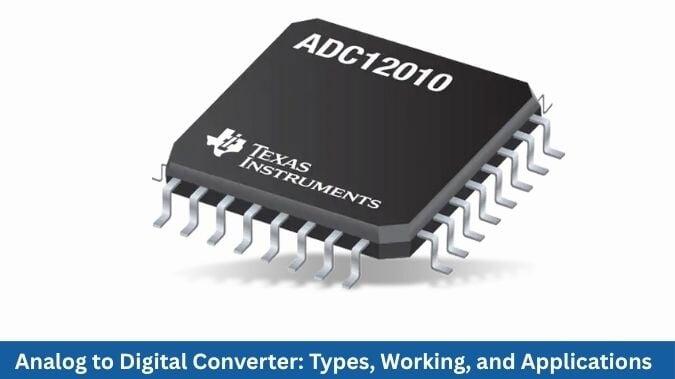What is an Analog to Digital Converter (ADC)?
An analog-to-digital converter is a device that is used to convert the continuous analog signals (voltage or current) into discrete digital numbers or digital data that various devices can process, like microcontrollers and ICs.
In simple words, ADC takes analog signals from the atmosphere, like temperature, sound, or light, with the help of a sensor, and transforms them into a digital form. ADC is widely used in all electronics domains like communication systems, embedded systems and microcontrollers, automotive sensors, and IoT devices, etc.
Types of Analog to Digital Converters
1. Sigma Delta ADC
Sigma Delta ADC works well for low- to medium-speed applications and provides very high resolution with excellent noise performance. These are widely used in audio signal processing, precision measurement instruments, and digital audio converters.
2. Successive Approximation Register (SAR) ADC
This is the most common ADC type used in microcontrollers which offers a good balance of speed, resolution, and power efficiency. It is used in applications like data acquisition systems, industrial controls, and instrumentation.
3. Flash ADC
This is the fastest type of ADC. It uses a bank of comparators for instant conversion and is suitable for high-speed applications like digital oscilloscopes, radar systems, and RF signal sampling.
4. Dual Slope ADC
Dual slope ADCs are known for their high accuracy and noise rejection, but have relatively slow conversion speed. They are commonly used in digital multimeters and precision measurement devices.
5. Pipelined ADC
Pipelined ADC provides a good combination of high speed and medium-to-high resolution. They are often used in video, communications, and high-speed data acquisition systems.
6. Integration ADC
Integration ADC converts by integrating the input signal over a period. They are known for rejecting noise and line-frequency interference. They are used in low-speed, high-accuracy applications like digital voltmeters.
7.Time-Interleaved ADC
They use multiple ADC cores working in parallel to increase effective sampling rate and are suitable for very high-speed data converters in communications and test equipment.
8. Counter Type ADC
These ADCs use a counter and a DAC to perform conversion. They are simple in design but have a slow speed. They are rarely used in modern applications due to speed limitations.
How Does an ADC Work?
An analog-to-digital converter (ADC) works by sampling a continuous analog signal at discrete time intervals.
It measures the amplitude of the input signal at each sampling point.
The continuous amplitude is then quantized into a finite number of levels based on the ADC’s resolution (e.g., 8-bit, 12-bit, 16-bit).
Each quantized level is assigned a unique binary code that represents the analog value digitally.
The sampling process must follow the Nyquist theorem to prevent signal aliasing.
An internal clock controls the sampling rate, defining how many samples per second the ADC takes.
The conversion process involves three steps: sampling, quantization, and encoding.
Some ADCs use a sample-and-hold circuit to maintain the input voltage constant during conversion.
Different architectures like SAR, Sigma-Delta, Flash, or Dual Slope use varying techniques to achieve this process.
The resulting digital output can be read by a microcontroller, processor, or digital system for further processing, storage, or transmission.
Applications of ADC in Electronics
To capture and digitize high-frequency analog signals for measurement and analysis, ADCs are used in digital oscilloscopes and signal analyzers.
ADCs are essential in data acquisition systems (DAQ) for converting sensor signals like temperature, pressure, and humidity into digital form.
Integrated in medical equipment like ECG machines, MRI scanners, and digital thermometers for precise bio-signal processing.
Found in embedded systems and microcontrollers to read analog inputs like voltage, current, or light intensity.
Applied in automotive electronics for processing signals from sensors such as accelerometers, gyroscopes, and proximity detectors.
Advantages of ADC
ADC converts real-world analog signals into digital data for easy processing, storage, and transmission.
They enable digital systems like microcontrollers, computers, and DSPs to interact with physical environments.
ADCs offer high accuracy and precision with modern high-resolution ADCs.
ADCs support complex digital signal processing techniques for enhanced performance.
Allows multi-channel data acquisition with multiplexed ADCs in embedded systems.
Limitations of ADC
High-resolution ADCs may have slower conversion speeds and higher power consumption.
ADCs require precise clocking and sampling rates to avoid aliasing and data loss.
ADCs can generate digital noise that needs filtering in sensitive applications.
ADCs add circuit complexity and cost to electronic system design.
ADCs can affect the performance by temperature variations, non-linearity, and input noise.
Final Thoughts
Analog to digital converters (ADCs) play a vital role in bridging the gap between the analog real world and digital electronics. From smartphones and medical devices to industrial automation and IoT systems, ADCs enable accurate signal conversion for smarter processing.
Choosing the right ADC type, resolution, and sampling rate is crucial for achieving reliable performance. Despite their limitations, ADCs continue to evolve with advanced architectures and improved efficiency.
Understanding how ADCs work helps engineers design better, more connected devices. Ultimately, ADCs are the foundation for innovations that make modern life smarter and more data-driven.
Analog to Digital Converter- FAQs
1. What factors affect the accuracy of an ADC?
The accuracy of an ADC is affected by factors such as resolution, sampling rate, quantization error, noise, non-linearity, and temperature variations.
2. Do all microcontrollers have built-in ADCs?
No, not all microcontrollers have built-in ADCs; it depends on the specific microcontroller model and its intended application.
3. Why is the sampling rate important in ADC?
The sampling rate is important in an ADC because it determines how accurately the analog signal is captured and affects the resolution of fast-changing signals.
4. Can ADC convert negative voltage signals?
Yes, ADCs can convert negative voltage signals, but they require level shifting or differential input configurations to handle negative voltages properly.
5. What is aliasing in ADC, and how can it be prevented?
Aliasing in ADC occurs when the input signal is sampled below the Nyquist rate, causing distortion, and it can be prevented by using an anti-aliasing filter before sampling.


